Effectiveness of treatmentback, back painit depends on how accurately it is delivereddiagnosis. . . However, pain syndrome itself is not some characteristic symptom - it is a common symptom for which it is impossible to determine the cause of the disease. There are many different pathologies that can cause itback, back pain, and not all of them are associated with diseases of the musculoskeletal system.
When self-medicating, patients mistakenly believe that the most important thing is to cope with the pain, and forget that every pain has a cause. Taking painkillers is a symptomatic treatment that does not affect the outcome of the disease or the cause of the pain.
The main causes of back pain
Consider the basicsdiseasecausesback, back pain. . . For ease of diagnosis, doctors divide the back into upper (cervical spine), middle (thoracic spine) and lower (lumbosacral) parts.
Upper back pain

Pain in the cervical spine requires the most attention. The reason is the unique anatomical features of the cervical vertebrae: the spinal artery supplies blood to ⅓ part of the brain through them; the first and second cervical vertebrae form a mobile complex articulation with the skull, which is responsible for turning and bending the head; Any disease that occurs at this level has the potential for serious neurological damage, as damage or even slight compression of the spinal cord in the spinal cord immediately results in impaired motor and / or sensory function in the rest of the body.
Osteochondrosis of the cervical spine
Normally, intervertebral discs, joints, ligaments, and tendons do not have their own blood vessels, and their blood supply depends on how intensively the nearby muscles and bones are supplied with blood. If this process is disrupted, for example, in an office worker who leads a sedentary and sedentary lifestyle, they begin degenerative-dystrophic changes. The nutrition of the cartilage of the intervertebral discs and joints is impaired, the ligaments and tendons thicken, as a result of sclerotic changes, the spinal canal narrows and the distance between the vertebrae decreases.
Among non-specialists, this disease is known as spinal osteochondrosis. Although degenerative-dystrophic processes are common to the entire spine, the most common cause of pain in the cervical spine is osteochondrosis. In addition, as with other parts of the spine, the disease can be complicated by an intervertebral hernia. However, due to the anatomy of the cervical spine, even a small hernia can cause serious complications.
Trauma
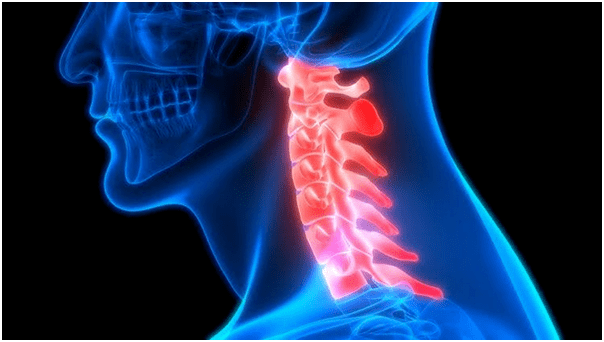
Although spinal cord injury is more commonly diagnosed in the lumbar region, approximately 50% of spinal cord injuries occur with spinal cord trauma. This is due to the characteristics of the anatomy of the neck: the lack of a developed muscular frame and massive vertebrae, high mobility contributes to trauma even without direct physical impact (for example, during a sudden stop or rear impact. Accident, so-called lash injuryoccurs as a result of bending and sharp elongation of the cervical spine). Pain is a constant companion of any spinal cord injury.
Myositis
Myositis or inflammatory muscle disease is a group of all diseases characterized by muscle pain. The most common cause of banal muscle inflammation is hypothermia, forced posture during exercise, drafting. Muscle pain can be the result of osteochondrosis of the cervical spine, an intervertebral hernia - the muscles take over most of the load on the neck, resulting in overload, microcirculation and muscle spasms with disruption of microcirculation and inflammation.
Neuralgia
Neuralgia is a condition in which the nerve fibers themselves become a source of constant pain impulses. The pain is paroxysmal, dizziness or bending of the head, which can be intensified and provoked by cold weather. The cause of neuralgia is associated with diseases of the spine - osteochondrosis, intervertebral hernia, scoliosis, etc. The direct cause of pain is irritation when the roots of the spinal cord are compressed in the intervertebral space, muscle spasm, disruption of metabolism in the nerves passing through the spasmodic muscles. Unlike neuritis or inflammation of the nerve, the pain with neuralgia is periodic, with no pathological changes in the nerve fibers themselves.
Heart disease
Heart diseases such as angina pectoris, coronary heart disease, and coronary atherosclerosis are often accompanied by pain in the left neck, lower jaw, shoulder, and forearm. Pain, numbness, tingling in the skin, may be accompanied by pain simulation in osteochondrosis of the cervical spine with an intervertebral hernia. Often patients receive massage, physiotherapy, and consult other doctors, although an electrocardiogram is sufficient to determine the cause.
A characteristic feature of such pain is the ability of antianginal drugs that improve blood flow through the coronary arteries (isoket, nitroglycerin) to relieve pain in a few minutes.
Pain in the middle of the back
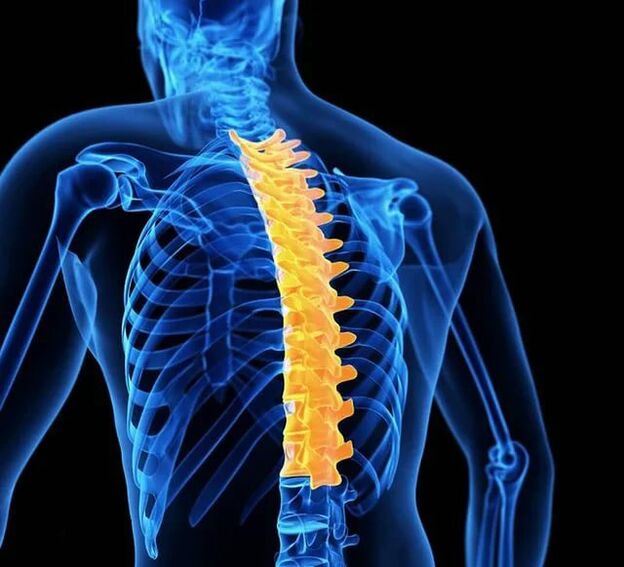
The thoracic spine consists of 12 thoracic vertebrae, each with a pair of ribs. Together they protect the chest organs. The size of the thoracic vertebrae gradually increases from 1 thoracic vertebra and then to the beginning of the lumbar vertebrae - this is explained by the gradual increase in the load on them. The mobility of the middle part of the spine is significantly lower than the mobility of the neck, the ribs provide additional protection, so traumatic injury to the spinal cord is less common.
Spinal curvature or scoliosis
Scoliosis or scoliosis is a pathological curvature of the spine in several planes. The causes of scoliosis are still unknown, the disease begins in childhood. Lack of physical activity, weakness of the back muscles, proper posture of schoolchildren and the organization of the workplace are among the factors that create conditions. Due to the open curvature, the distribution of loads and the violation of the biomechanics of the spine, the overload of the muscles that compensate for part of the load,arisechronicback, back pain.
Arthritis (spondyloarthritis)
The intervertebral joints, together with the intervertebral discs, connect the spine as a whole. Each vertebra has 4 articular surfaces that form joints with adjacent vertebrae. Like any other joint, the intervertebral joints can become inflamed. This pathological condition is called spondyloarthritis. There are two main causes of inflammation of the intervertebral joints. These include systemic rheumatic diseases (eg, rheumatoid arthritis or ankylosing spondylitis) or reactive inflammation that occur in response to increased loads in osteochondrosis, scoliosis, and other spinal pathologies. Inflamed joints lose function: stiffness of movements, stiffness of the spine, back pain for a long time.
Diseases of the gastrointestinal tract and back pain
Diseases of the abdominal organs are often the cause of pain in the back and spine. There is a direct link between pathologies of the gastrointestinal tract and diseases of the musculoskeletal system. Diseases such as chronic colitis or gastroenteritis are the background of spondyloarthritis or osteochondrosis of the spine.
Low back pain, often associated with pain, occurs with gastric and duodenal ulcers, hiatal hernia, acute or chronic pancreatitis. This phenomenon is due to the characteristics of the sympathetic and parasympathetic systems, which have nerve fibers in each organ of the abdominal cavity. Some of the pain impulses received by them return to the roots of the spinal cord, simulating pain in the spine and back.
Kidney disease and back pain
The kidneys, like the organs of the abdominal cavity, are a paired organ located in the retroperitoneal cavity that is closely connected to the nerves by the roots of the spinal cord. In the presence of inflammation, stones or other pathologies of the urinary tract, some of the pain impulses reach the spinal cord, simulating a disease of the spine.Symptoms of back paincan occur with acute pyelonephritis, renal colic, renal abscesses. A characteristic symptom is tension in the back muscles in the projection of the kidneys, which occurs with inflammation of the kidneys or an abscess of the tissue surrounding them.
Pain in the lumbar-sacral spine

The lumbar-sacral spine has the greatest stress. About 60-70% of the adult population in developed countries suffer from back pain. This is a favorite localization of intervertebral hernias. One patient is diagnosed with 2-3 hernias of the most lumbosacral lumbar spine. Also, pain in the spine and sacrum often occurs with gynecological and urological pathologies.
Intervertebral hernia
An intervertebral hernia is the result of long-term osteochondrosis of the spine. While small loads are placed on the cervical region relative to the intervertebral discs, each disc has greater pressure in the lumbosacral region. A solid disc can compensate for any weight due to the semi-liquid core, which acts as a hydraulic shock absorber. However, due to osteochondrosis, the fibrous and strong cartilage (annulus fibrosus) extending along the periphery of the intervertebral disc loses its elasticity and strength, and some parts of it may crack. With a sharp increase in load, for example, when lifting weights, the pressure inside the patient's disc increases, so its contents can fall into the lumen of the spinal canal and really "hit" the damaged cartilage - that's it. intervertebral hernia.
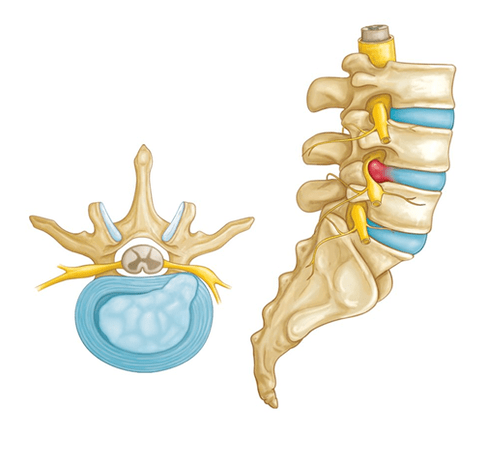
Fragments of the nucleus that fall from the disc compress the spinal cord and spinal cord. As a result, there is swelling of nerve tissue and circulatory disorders, accompanied by severe pain and protective muscle spasms. The pain can be unbearable until you need to use narcotic analgesics. A characteristic feature is the radiation of pain in the lower extremities. There may be impaired sensitivity to pain, tingling and numbness of the skin of the lower leg and thigh.
Protrusion of the intervertebral disc
The main difference between an intervertebral disc protrusion and a hernia is the preservation of the integrity of the annulus fibrosus. The cause of the pain is compression of the spinal cord and its roots by a protrusion along the periphery of the intervertebral disc. However, if the process continues, the bulge can easily turn into a hernia. The symptoms and pain are similar to a disc herniation, because the severity of the pain syndrome depends not only on the size, but also on the location of the protrusion or hernia.
Spondylosis of the spine
Overload and degenerative-dystrophic processes in the spine can lead to the ossification of cartilage tissue saturated with calcium salts and turn into acute coracoid bone protrusions or growths along the periphery of the vertebral bodies. As the process progresses, these protrusions may combine with the same growths in the body of adjacent vertebrae. Over time, all vertebrae grow together, losing the elasticity and resilience of the spine. Pain occurs as a result of irritation of the spinal cord and its roots, reactive inflammation and dystrophy of the soft tissues, ligaments and muscles surrounding the spine.
Radiculitis
Radiculitis is a severe pain caused by osteochondrosis of the spine, suffocated by a hernia or bulge, circulatory disorders and ischemia of the spinal cord. Various disorders of skin sensitivity are possible in the chest, perineum, thighs and lower legs. Causes sciatic muscle atrophy and weakness. A characteristic symptom is shooting pains along the sciatic nerve, aggravated by movement, weight lifting, and cold weather. This condition is called sciatica or sciatica.
Spinal infection
The vertebrae are made of sponge bone tissue, which is rich in bone marrow. When an infection enters the bloodstream in the body of the vertebrae, an inflammatory process can occur - osteomyelitis. Gradual degeneration of bone tissue is accompanied by necrosis - this picture is also characteristic of spinal tuberculosis. The pain can be caused by both irritation of the nerve endings and pathological compression fractures of the spine weakened by inflammation.
Gynecological and urological diseases
In women, pathologies such as cervical cancer, endometriosis or adnexitis (inflammation of the uterine appendages), in men, prostatitis or prostate cancer are often accompanied by severe pain in the lumbosacral spine. The nature of the pain is explained by irritation of the nerves trapped in the area of inflammation or enlargement of the nerve trunks by a tumor.
The back muscles ache along the spine
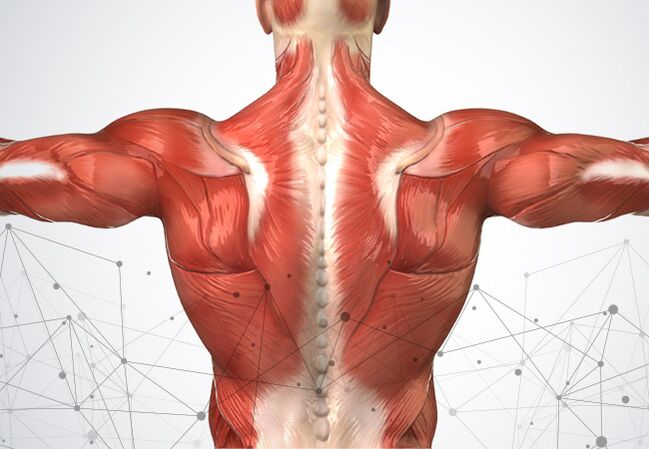
Well-developed back muscles are a sign of a healthy spine, because the muscle corset relieves some of the stress and additionally stabilizes the spine. In chronic diseases of the spine, the muscles are subjected to excessive loads, and weak and atrophied muscles can not withstand. As a result, muscle spasms occur and are due to metabolic disorders in the muscles and pain. This condition is called myofascial syndrome, which is characteristic of osteochondrosis of the spine, hernias and protrusions of the intervertebral discs.
Postoperative pain
Spinal surgeries are usually accompanied by extensive trauma - to stabilize and restore the integrity of the spine, doctors may resort to the installation of metal structures, screws to the vertebrae, and the removal of unstable tissue. In this case, the pain is caused not only by the disease itself, but also by surgery. With proper rehabilitation and postoperative care, the pain will gradually disappear. However, if you ignore the doctor's instructions in the postoperative period and ignore the mandatory exercises, the pain can become chronic.
How are the causes of low back pain determined?
Seek medical attention from a qualified neurologist in a timely manner to diagnose back and spine pain. In the first stage, a neurological examination, patient questioning, examination of reflexes and symptoms are performed. An experienced and skilled doctor is well aware of the diseases that cause back and spine pain for certain reasons and characteristics.
Back pain for no reason should be especially careful. This can be with reflex pain, tumors and diseases of other organs and systems.
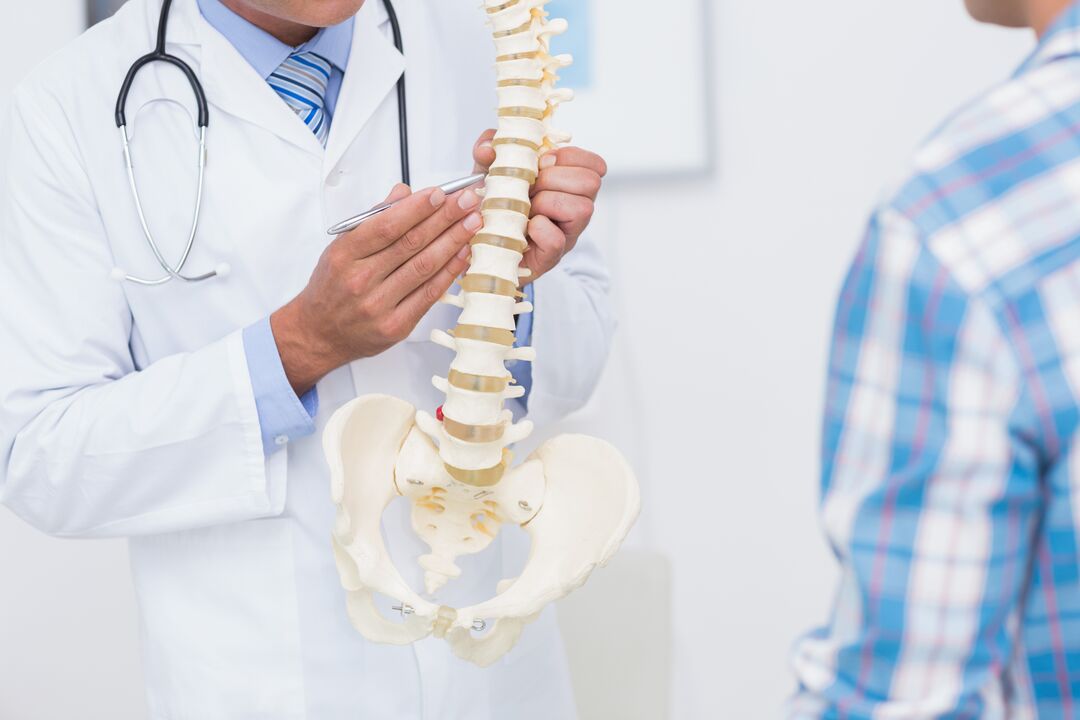
A neurologist may order magnetic resonance imaging to find out why your back and spine hurt. This is the most effective and safest way to detect almost all possible causes of back pain. The procedure is based on the ability of magnetic fields and radio waves to give clear and detailed images of the spine and spinal cord without the use of X-rays and other harmful factors.
How to relieve back pain
Let's take analgesics to relieve back pain, but not to treat, you need to wait a few days to consult a specialist. Non-steroidal anti-inflammatory drugs or NSAIDs are often used for this purpose. However, it should be remembered that this group of drugs can cause dangerous side effects, the likelihood of which increases with long-term use. Therefore, it is important not to delay a visit to the doctor and examination. treatmentdiseasesspineand causesback, back pain.
Treatment of back pain
As mentioned earlier, the effectiveness of back pain treatment depends on how accurate the diagnosis is. Despite the clarity, many patients "treat" the pain for years, but not the disease itself, but delays a visit to the doctor every time, consulting traditional healers, osteopaths and chiropractors. Moreover, for some diseases of the spine, such procedures are not only contraindicated, but also dangerous.
There are effective and scientifically proven treatments for different typestypesdiseases that causeback, back pain. . . Many of these require the patient to persevere and persevere in the fight against the disease. Keep in mind that there are no pills or needles that can treat osteochondrosis - you can only do this with strenuous exercise and physical exercise that your neurologist will show you.
Which doctor should I see for back pain?
Back pain is one of the most common neurological symptoms due to the involvement of nerves and spinal cord in the pathological process. Therefore, the first specialist to be consulted during spinal pain will be a neurologist. Based on the results of the examination and magnetic resonance imaging, you should consult another doctor. If back pain is caused by heart disease, the patient is referred to a cardiologist, if the problem is in the digestive system, to a gastroenterologist. However, most pain syndromes are clearly associated with spinal pathology.

















































